My daughter has sensory processing disorder. She was about two years old when it was first diagnosed. I’d never heard of it before, but it helped make sense of a lot of things. And because of SPD, our homeschooling has changed. How do you homeschool sensory processing disorder kids?
What is SPD?
SPD or Sensory Processing Disorder is when the sensory systems and the brain aren’t working well together. There are different types of SPD, but all of them can impact a child’s ability to learn and function, and their overall quality of life.
OVER REACTIVE AKA Hypersensitive
Some types of SPD are caused when the nervous system overreacts to the sensory input.
So bright lights, loud noises, certain types of textures or temperatures can be overwhelming to the child. These inputs set off pain signals in the child’s brain. They can be anything from merely irritating (think itchy wool sweaters!) to physically painful.

The child’s reaction may range from distraction and general irritation to physical distress. They may run away (flight response) or have a meltdown — which can be misinterpreted as a temper tantrum. But the reaction will seem atypical and over-the-top to the sensory input, making it a huge interruption in the life of the child and the family.
UNDER REACTIVE or HYPOSENSITIVE
Some types of SPD are caused when the nervous system doesn’t react or reacts slowly or poorly to sensory inputs.
For example, the child may have difficulty being aware of where their body is in relation to objects around them, or challenges in balance and internal orientation. Their body will be looking for reassurance, and so the child will be constantly looking for sensory input.
The child’s reaction may range from constant movement and mild clumsiness to risk-taking and self-harm behaviours. Since their brains aren’t getting enough of the right signals, their body is constantly seeking sensory input. These kids will have problems keeping themselves upright, and respecting personal space of others. They may seem like they’re constantly bouncing off walls, looking for hugs or hitting others, and can be aggressive. And that can be misinterpreted as just bad behaviour and a lack of self-control.
So how do you homeschool a child with sensory needs?
First, What Kind?
Many children have both kinds of sensory needs — both too much and too little. Some kids may freak out over the sound of an electronic pencil sharpener, but also seem to chew on everything. Others might find it difficult to concentrate in bright light, but also will be covered in bruises and scrapes, because they are always falling off their chair or running into walls and doorframes.
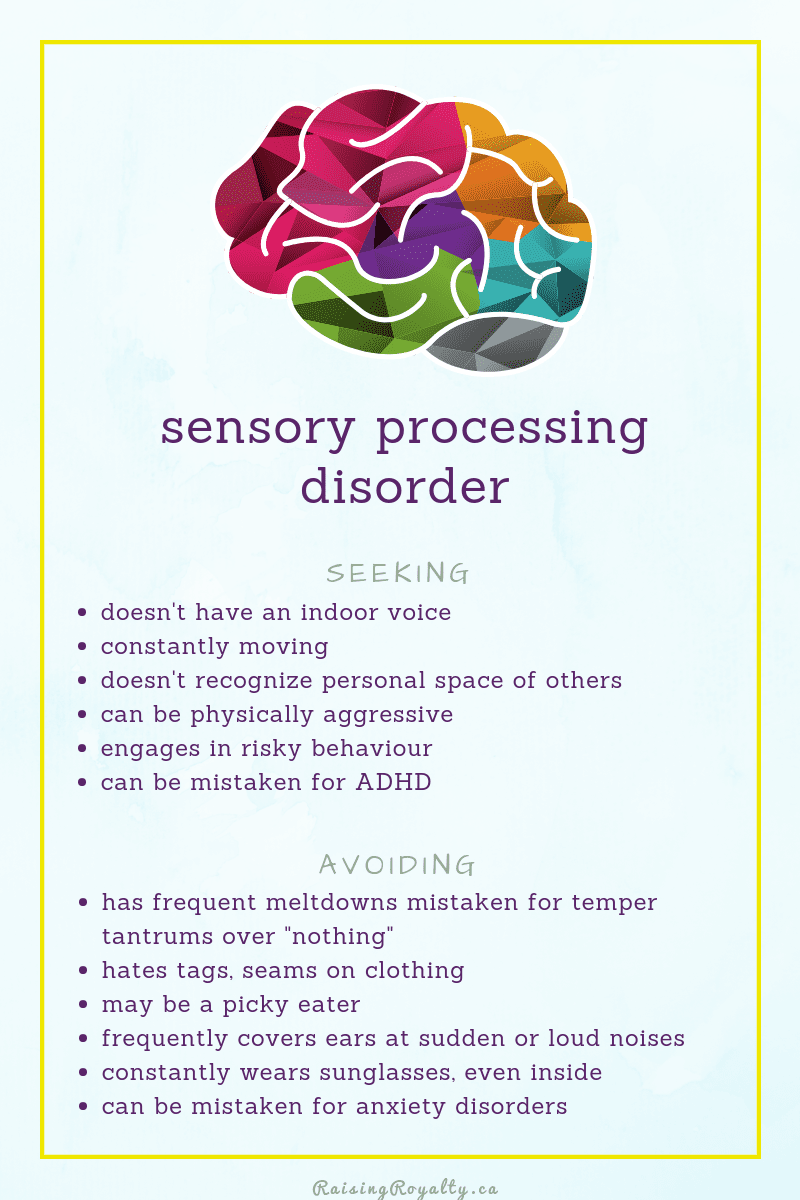
If you suspect your child may have sensory issues, you can get an assessment done with an occupational therapist. Sometimes, you can even get a free screening done at an early-childhood wellness clinic, or you may need to talk to your doctor for a referral. An OT can also give you an idea of what kinds of sensory needs your child may have.
Tips to help
Here are a few things you can do to help a child with SPD.
Movement breaks
Every child needs to move, frequently and regularly. But SPD kids can need this even more! Build regular movement breaks into your homeschool schedule or routine, and it may help your child concentrate longer.
Movement breaks don’t have to be long or involved. Here’s a list of ideas:
- 10 jumps (maybe on a mini trampoline)
- 5 squats off a hard chair
- 15 minute dance break
- Run around the outside of the house 2x
- Stand on your head on the back of the couch
If you have a child with an underfunctioning nervous system, you may want to have some equipment to help with movement breaks. This includes:
- a mini trampoline
- a large exercise ball
- a crash pad (a futon mattress works well!)
- a balance beam (a 4×4 block of lumber would work for this, flat on the floor)
- a large bean bag chair
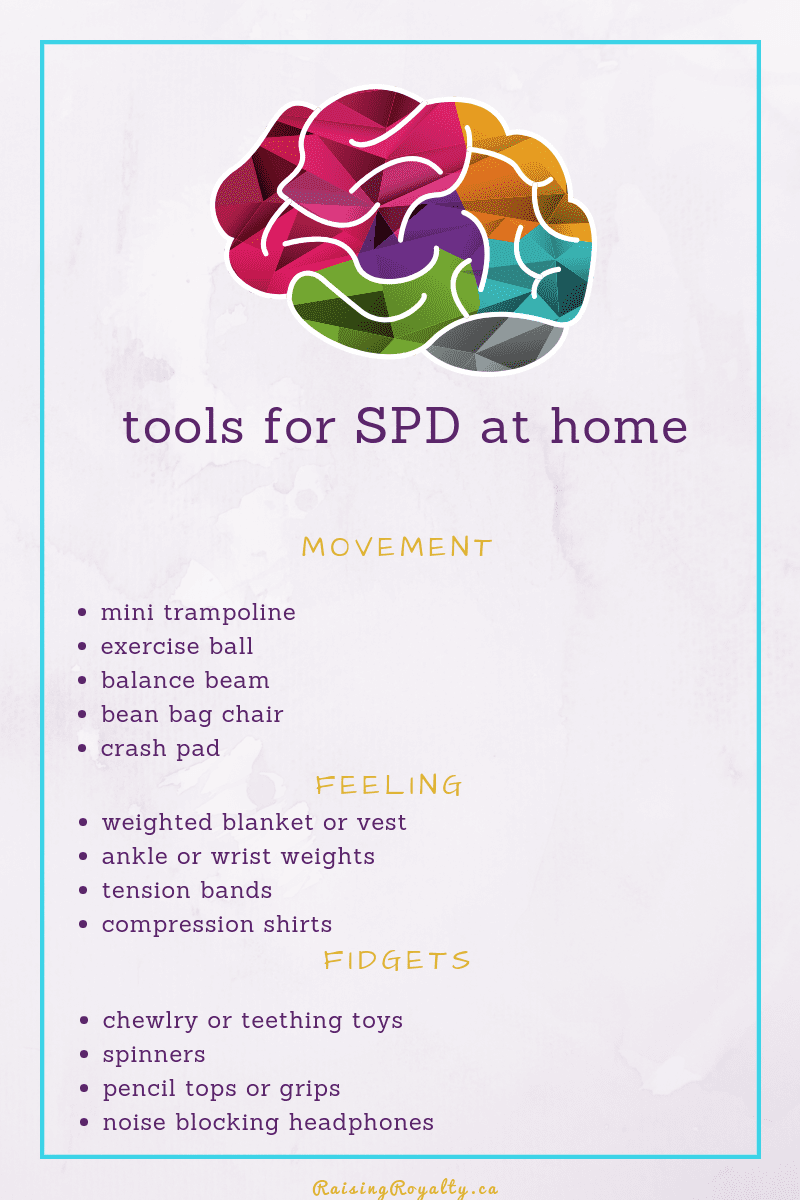
Weights, fidgets and tension
Sometimes kids with SPD need to fidget or need tools to help them concentrate. While movement breaks help, what if your child chews on their pencil or sucks on their shirt?
There are easy-to-get tools to help with kids who need to fidget.
- Pencil fidgets
- Chewlry
- Tension band
- Ankle weights
- Weighted blanket
- Weighted vest
- Compression undershirt
- Spinners
These simple little tools can make it a whole lot easier for your child to be able to concentrate. And they can help calm an anxious child too!
Scents, tastes and sounds
Not all sensory needs are related to physical movement or feeling. There are 4 other senses to deal with too!
Some kids find sounds overwhelming and distracting.
This can result in ADHD-like symptoms. But before you try ADHD meds, try simple tricks to help with audio overstimulation.
- Buy noise-cancelling headphones.
- Turn on classical music and drown out the rest of the noise.
- Try audio books or podcasts in the background as “white noise”.
Some kids struggle with the wrong kind of lighting.
This can actually be audio as well as visual stimulation. Some kinds of lights will give out a hum that drives kids with SPD nuts. Florescent lighting is particularly bad for that. So check that your lightbulbs aren’t the cause of a problem and change them if they are.
The color of the light can also cause an issue. While some children thrive with natural light, other children need low lights to focus. And some kids need red or orange-shift light while others need blue and white light to be able to concentrate.
And if the light is simply too bright, turn off the overhead lights, and use lamps instead. Or let your child wear light-colored sunglasses indoors. A good opthamologist can test for light sensitivity as well, and if it’s causing eye strain, you may want to get tinted glasses for your child, to prevent vision problems later on.
Some kids find smells particularly stimulating.
And if this is your kid, you might be able to take advantage of it. You may be able to help your child manage their moods by diffusing essential oils or using room sprays with particular scents.
No one can concentrate well in a room with a stinky odor. A child with SPD may find a bad smell overwhelming to the point of tears — even if you can’t smell a thing. Keeping their rooms clean and odor-free will go a long way to helping your child function, and will probably help them sleep.
To help them focus, citrus or peppermint scents are said to be good. And to calm, try lavender or spruce. There are lots of resources on aromatherapy out there.
Some kids need the right taste.
While eating doesn’t directly impact a child’s ability to learn, it does indirectly. After all, a hungry child isn’t going to be able to concentrate on anything. And if your child is a super picky eater, it might be because of SPD issues.
Eating issues and SPD tend to go hand in hand. Some kids have to have the blandest foods possible, because they get overwhelmed with even a hint of flavor. And other kids crave spicy or savory foods, because they can’t taste them otherwise.
There are 5 different kinds of tastes — salt, savory, sweet, bitter and sour. Your child may react differently to the various combinations, based on just how their senses interpret the different tastes. And that doesn’t take into consideration food temperature or texture. No wonder some kids struggle to eat!
Finding the right combination of taste, texture and temperature can feel like playing the lottery. You may need to consider seeing a dietitian and an OT for sensory desensitization therapy, if your child has overwhelming feeding issues.
DIY your sensory tools
Some sensory tools can cost a lot of money, but there are some things you can do yourself.
- If your child struggles with feeling their body in space and balancing, try putting plastic baggies with dry rice in them, in the pockets of their pants or a vest. The extra weight can help them feel their own bodies and stay still longer.
- If your child seems to be constantly standing and then sitting, try using a tension elastic around the legs of their chair or the table. They can push against it with their feet as needed, without interrupting their own focus.
- If your child seems to constantly chew on their shirts or pencil ends, try getting a large teething necklace. They can suck on or chew on that instead, without hurting their teeth.
Sensory processing disorder can be challenging to live with, let alone homeschool. And your child’s reactions to ordinary things can make you scratch your head.
My daughter will scream bloody murder if she gets a paper cut or scrapes her knee. But I’ve seen her miss the door and run full tilt into a wall, bounce off, correct herself, and keep going as though nothing happened. Fire alarms and smoke alarms make her cry and panic. But she loves to sing! And she loves to sing loud!
Sensory processing disorder can’t be cured, but you can manage it. Use tools and work with it, rather than trying to insist a child fight their own reactions. Both you and your child will be happier. And homeschooling will be easier.
Need help getting started? Get the ebook: Getting Started with Homeschooling!
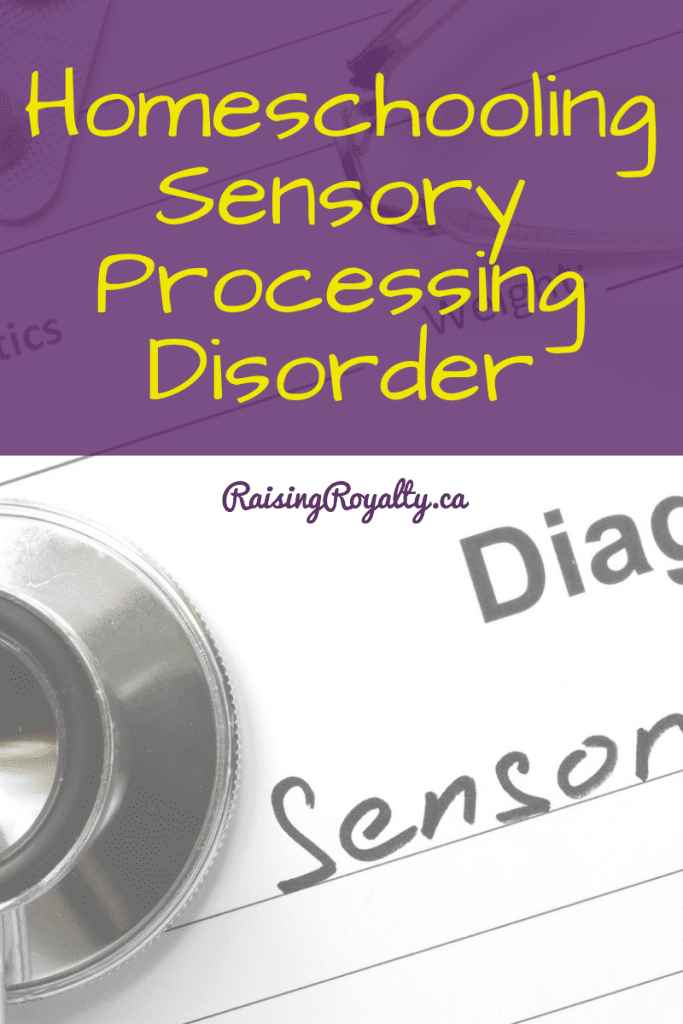
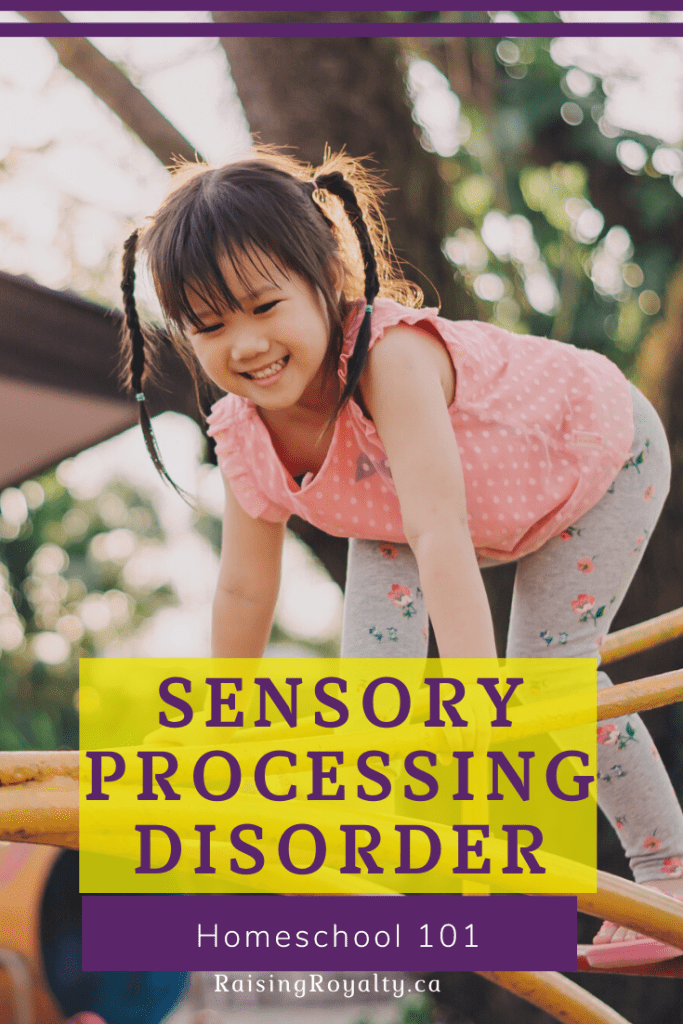

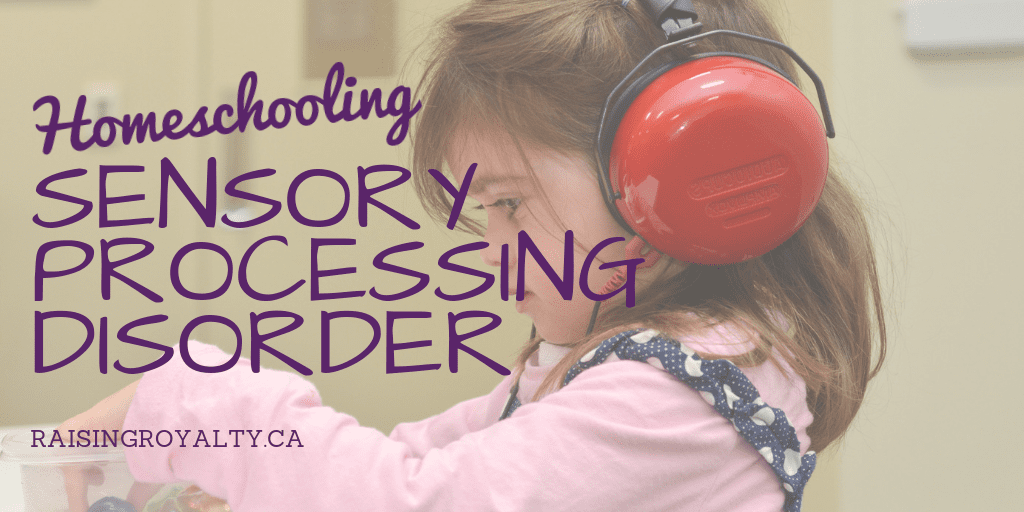

I just want to buy your home school 201 book and I can’t find it I’ll download it whatever it is you can send me a link I would appreciate it
Hi Holly!
You can get the Homeschool 101 book here: https://raisingroyalty.ca/product/get-started-homeschooling/
This is great thank you, really like the tools for SPD at home and DIY your sensory tools section.
https://www.bloomingtherapies.ca/
Hi,
I enjoyed your article. I work with Early Intervention here in Alabama. I would like to know how did you get your child tested for Sensory Processing disorder. Most of the kids I work with have been diagnosed with autism but seem to have a lot of sensory issues. Usually they are never diagnosed with sensory processing disorder but autism.
SPD and sensory processing issues aren’t usually a stand-alone diagnosis. They’re typically made as part of other diagnoses, usually with a variety of developmental disorders and other neurodivergence. The best people to talk to about sensory processing issues, including sensory processing disorder are OTs (for all types of sensory issues, but specifically tactile, oral, vestibular, proprioceptive, and interoceptive sensory issues), audiologists (for auditory issues, including diagnosing APD – auditory processing disorder), ophthalmologists (for issues related to visual processing, including visual tracking, visual convergence, and light sensitivity), and ear-nose-throat specialists for olfactory issues. A dietician might be able to help with oral issues, especially with oral sensory issues that impact eating.
My daughter was diagnosed with SPD by an OT, and later confirmed by a developmental pediatrician, as part of our diagnostic journey.